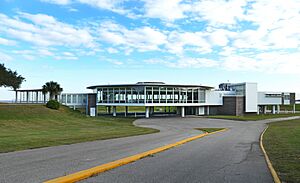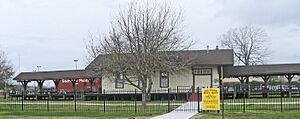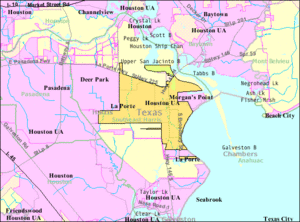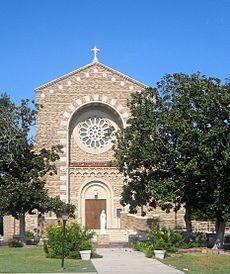La Porte, Texas facts for kids
Quick facts for kids
City of La Porte
|
|
|---|---|
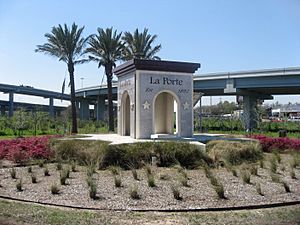
Welcome to La Porte
|
|
| Nickname(s):
"L.P."
|
|
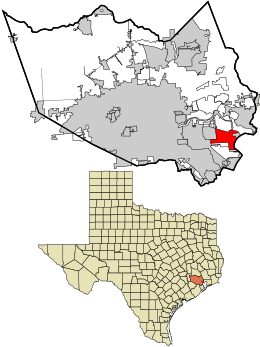
Location in Harris County and the state of Texas
|
|
| Country | United States |
| State | Texas |
| County | Harris |
| Government | |
| • Type | Council-Manager |
| Area | |
| • Total | 19.90 sq mi (51.55 km2) |
| • Land | 18.60 sq mi (48.18 km2) |
| • Water | 1.30 sq mi (3.36 km2) |
| Elevation | 20 ft (6 m) |
| Population
(2020)
|
|
| • Total | 35,124 |
| • Density | 1,880.03/sq mi (725.90/km2) |
| Time zone | UTC-6 (Central (CST)) |
| • Summer (DST) | UTC-5 (CDT) |
| ZIP codes |
77571-77572
|
| Area codes | 713, 281, 832, 346 |
| FIPS code | 48-41440 |
| GNIS feature ID | 2411580 |
La Porte (pronounced "lə PORT") is a city in Harris County, Texas, United States. It is part of the larger Greater Houston area. In 2020, about 35,124 people lived there. La Porte is the fourth-largest city in Harris County.
La Porte is important for international trade. It is home to the Barbours Cut Terminal and the Bayport Terminal. These are busy shipping ports operated by the Port of Houston Authority.
The area near La Porte is famous in Texas history. The Battle of San Jacinto happened here on April 21, 1836. This battle ended the Texas Revolution. It helped Texas become independent from Mexico. The San Jacinto Monument is near La Porte and remembers this battle.
In the early 1900s, La Porte was a popular tourist spot. Its Sylvan Beach attracted many famous entertainers. Over time, the tourist business slowed down. Industries like oil and shipping grew instead. La Porte became a key part of the area's industrial growth.
Contents
Discovering La Porte's Past
The city of La Porte was started in 1892. It was a plan by investors to sell land. They set aside a 22-acre public space called Sylvan Grove by the water.
This area quickly became a fun place to visit. It had bathhouses, boating piers, and a Victorian hotel. There was also a dance pavilion. La Porte soon became the most popular tourist spot near Houston. In 1896, Sylvan Grove Park was renamed Sylvan Beach. Small vacation homes were built along the waterfront.
In 1900, a huge storm called the Galveston Hurricane hit. It caused a lot of damage to the city's attractions. But after the Texas Oil Boom started in 1901, La Porte quickly rebuilt. It became a tourist center again. However, it was damaged by a big fire and another hurricane in 1915. The community rebuilt once more.
During the 1920s and 1930s, Sylvan Beach Amusement Park became very famous. It hosted beauty contests and concerts by well-known bands. Performers like Guy Lombardo and Benny Goodman played there. In the 1930s, the park got a new boardwalk, rides, and many other attractions.
The beach started to shrink around 1928. This was due to erosion from ship wakes. Also, the land was sinking because too much groundwater was being used. During World War II, less tourism happened because of gas rationing. A hurricane in 1943 destroyed most of the tourist attractions. Many damaged buildings were not rebuilt. La Porte's tourist industry quickly declined. By the late 1900s, the beach was completely gone due to erosion.
As shipyards and factories grew nearby, La Porte's economy changed. The city's residents started working in these industries. The opening of the La Porte-Baytown tunnel in 1954 helped growth. Later, the Johnson Space Center was built nearby. The Barbours Cut shipping terminal and the Bayport Industrial District also opened. These developments made La Porte a successful industrial area.
Much of La Porte's history as a tourist spot is saved by the La Porte Bay Area Heritage Society. There are plans to bring back tourism to La Porte. A project to restore Sylvan Beach Park began in 2009. It finished in 2013, bringing in sand from other places.
Exploring La Porte's Geography
La Porte covers about 51.8 square kilometers (19.9 square miles). About 3.6 square kilometers (1.3 square miles) of this is water. The city has many small, older houses from the 1940s.
La Porte's Climate
The weather in La Porte has hot, humid summers. Winters are usually mild to cool. It has a humid subtropical climate. This means it gets a lot of rain and has warm temperatures.
Local Communities in La Porte
La Porte includes several communities. Lomax was once a separate town. It later became part of La Porte.
Understanding La Porte's Population
| Historical population | |||
|---|---|---|---|
| Census | Pop. | %± | |
| 1900 | 537 | — | |
| 1910 | 678 | 26.3% | |
| 1920 | 889 | 31.1% | |
| 1930 | 1,280 | 44.0% | |
| 1940 | 3,072 | 140.0% | |
| 1950 | 4,429 | 44.2% | |
| 1960 | 4,512 | 1.9% | |
| 1970 | 7,149 | 58.4% | |
| 1980 | 14,062 | 96.7% | |
| 1990 | 27,910 | 98.5% | |
| 2000 | 31,880 | 14.2% | |
| 2010 | 33,800 | 6.0% | |
| 2020 | 35,124 | 3.9% | |
| U.S. Decennial Census | |||
In 2020, La Porte had 35,124 people living there. There were 12,342 households and 9,148 families.
The city is home to people from many different backgrounds. In 2020, about half of the people were White (not Hispanic). About 37% of the population was Hispanic or Latino. There were also Black or African American, Asian, and Native American residents.
The average age in the city was 33 years old. About 29.7% of the population was under 18. The median income for a household was about $55,810.
La Porte's Economy
La Porte is next to three important economic areas. These are the Bayport Industrial District and the Battleground Industrial District. The Barbours Cut shipping terminal is also nearby. These areas are key to the economy of the Bay Area and Greater Houston.
Learning in La Porte
Students in La Porte attend schools in the La Porte Independent School District. This includes La Porte High School.
There are several elementary schools in La Porte. These include Jennie Reid, Rizzuto, Lomax, and La Porte Elementary. Bayshore, College Park, and Heritage Elementary are also part of the district. For middle school, students go to Baker Sixth Grade Campus, La Porte Junior High, or Lomax Junior High.
After high school, residents can attend San Jacinto College.
Public Libraries in La Porte
La Porte has a public library called the La Porte Branch Library. It is part of the Harris County Public Library system. The library first opened in 1929. The city takes care of the building. The Harris County Public Library runs the services.
There is also the Old Sylvan Beach Depot Museum and Library. It has many historical items about La Porte. The main building used to be a Southern Pacific Railroad depot. The site also has the original La Porte Library building and an old caboose.
Getting Around La Porte
Transportation Options
Harris County Transit offers public transportation in La Porte.
The city also has its own airport, the La Porte Municipal Airport.
For bigger flights, people use William P. Hobby Airport or George Bush Intercontinental Airport. Both are in Houston.
La Porte is connected to Interstate 10 by State Highway 146. This highway crosses the Fred Hartman Bridge into Baytown. The bridge was built in 1995. It replaced the Baytown Tunnel to allow larger ships in the Houston Ship Channel.
La Porte is located on the northwest side of Galveston Bay. It is at the mouth of the Buffalo Bayou and the San Jacinto River.
Famous People from La Porte
Many notable people have connections to La Porte:
- Jessica Boone: An actress who was born in La Porte. She went to La Porte High School.
- Kerron Clement: An Olympic gold and silver medalist in track and field.
- Sarah Emma Edmonds: A Canadian-born woman who served as a man in the American Civil War.
- Curvin Richards: A former NFL running back for the Dallas Cowboys and Detroit Lions.
- Shaun Rogers: An NFL player.
- Gene Washington: A two-time Pro Bowl player. He grew up in La Porte.
- L. Neil Smith: An American science fiction author and political activist.
- Terrel Bernard: An NFL Linebacker.
See also
 In Spanish: La Porte (Texas) para niños
In Spanish: La Porte (Texas) para niños


